Auto hold MITSUBISHI OUTLANDER 2020 (in English) Owner's Guide
[x] Cancel search | Manufacturer: MITSUBISHI, Model Year: 2020, Model line: OUTLANDER, Model: MITSUBISHI OUTLANDER 2020Pages: 443, PDF Size: 60.03 MB
Page 268 of 443

Indicator light, warning light, and information screen display list
Features and controls 5-187
5
The electronically controll
ed 4WD system is hot. Refer to “Elect
ronically controlled 4WD system” on
page 5-83.
The S-AWC system is hot. Refer to “S-AWC (Super-All Wheel Control)” on page
5-85.
The fuel is running low.
Refuel as soon as possible. Refer to “Fuel remaining
display screen” on page
5-164.
The outside temperature is 37 °F (3 °C) or less.
Be careful driving on frozen ground. The ground may be frozen even when this warning is not displayed, so
drive carefully.
The Adaptive Cruise Control System (ACC) has detected the approach of
the vehicles in front.
Increase the following distance by depressing the brake pedal or marking ot
her decelerating control.
Refer to “Adaptive Cruise Control System (ACC): Approach alarm” on page 5-112.
The Forward Collision Mi
tigation System (FCM)
has detected the danger of collision.
Take appropriate action such as depressing the brake to avoid collision.Refer to “Forward collis
ion warning function” on
page 5-120.
The Adaptive Cruise Control System (ACC) detected a stop of the ve
hicle in front and stopped
your vehicle, but the brak
e will be re
leased soon.
Depress the brake pedal
as soon as your vehicle
comes to a stop. Refer to “When ACC dete
cts a vehicle in front
within the set dist
ance” on page 5-111.
The Electric parking brak
e cannot be applied auto-
matically.
Depress the brake pedal as soon as possible. Refer to “Brake auto hold” on page 5-93.
Screen
Cause
Do this (Reference)
BK0278200US.book 187 ページ 2019年4月10日 水曜日 午前10時59分
Page 273 of 443
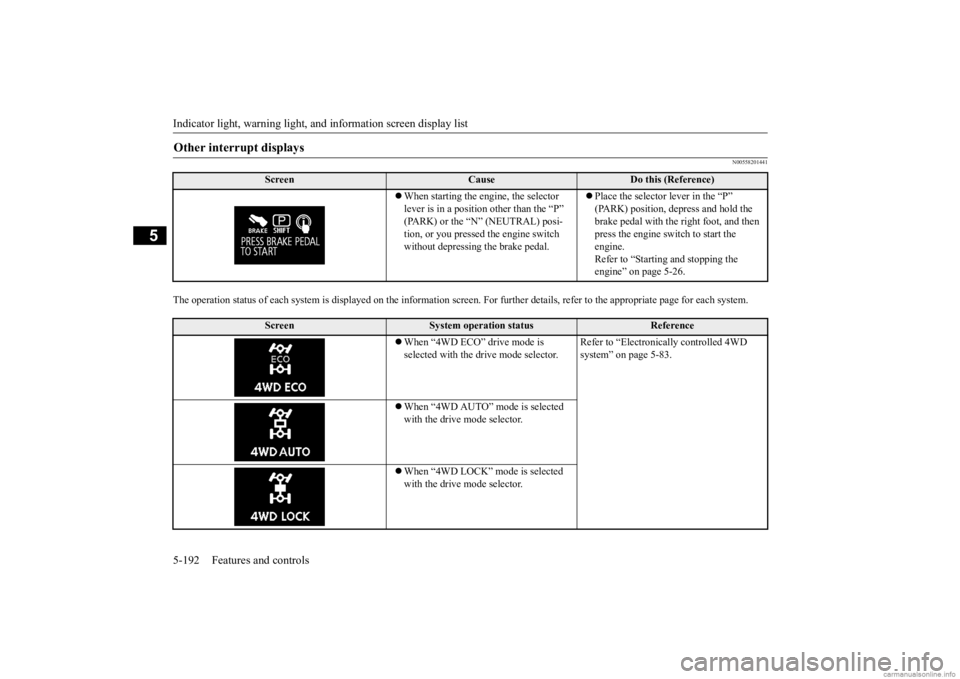
Indicator light, warning light, and information screen display list 5-192 Features and controls
5
N00558201441
The operation status of each system is displayed on the inform
ation screen. For further details,
refer to the appropriate page
for each system.
Other interrupt displays
Screen
Cause
Do this (Reference)
When starting the engine, the selector lever is in a position other than the “P” (PARK) or the “N” (NEUTRAL) posi-tion, or you pressed
the engine switch
without depressing the brake pedal.
Place the selector lever in the “P” (PARK) position, depress and hold the brake pedal with the right foot, and then press the engine sw
itch to start the
engine. Refer to “Starting and stopping the engine” on page 5-26.
Screen
System operation status
Reference
When “4WD ECO” drive mode is selected with the drive mode selector.
Refer to “Electronica
lly controlled 4WD
system” on page 5-83.
When “4WD AUTO” mode is selected with the drive mode selector. When “4WD LOCK” mode is selected with the drive mode selector.
BK0278200US.book 192 ページ 2019年4月10日 水曜日 午前10時59分
Page 313 of 443

Storage spaces 5-232 Features and controls
5
N00551501298
To open, pull the lever (A).
There is a card holder on the inside of the glove compartment.
Keep the lids of storage spaces closed while driving the vehicle. A lid or the contents of astorage space could ot
herwise cause injuries
during a sudden stop.NOTE
Do not leave valuables in any storage space when leaving the vehicle.1- Luggage floor box 2- Floor console box 3- Glove compartment 4- Sunglasses holder (if so equipped)CAUTION
Glove compartment
WA R N I N G An open glove compartment door can cause a serious injury or death to the frontpassenger in an accident, even if the pas- senger is wearing his/
her seat belt. Always
keep the glove comp
artment door closed
when driving.NOTE
When the lights are illuminated with the light switch in the “ ”, “ ”or “AUTO” position (vehicles with
automatic light con-
trol), the glove compartment light illumi- nates.
Card holder
BK0278200US.book 232 ページ 2019年4月10日 水曜日 午前10時59分
Page 314 of 443
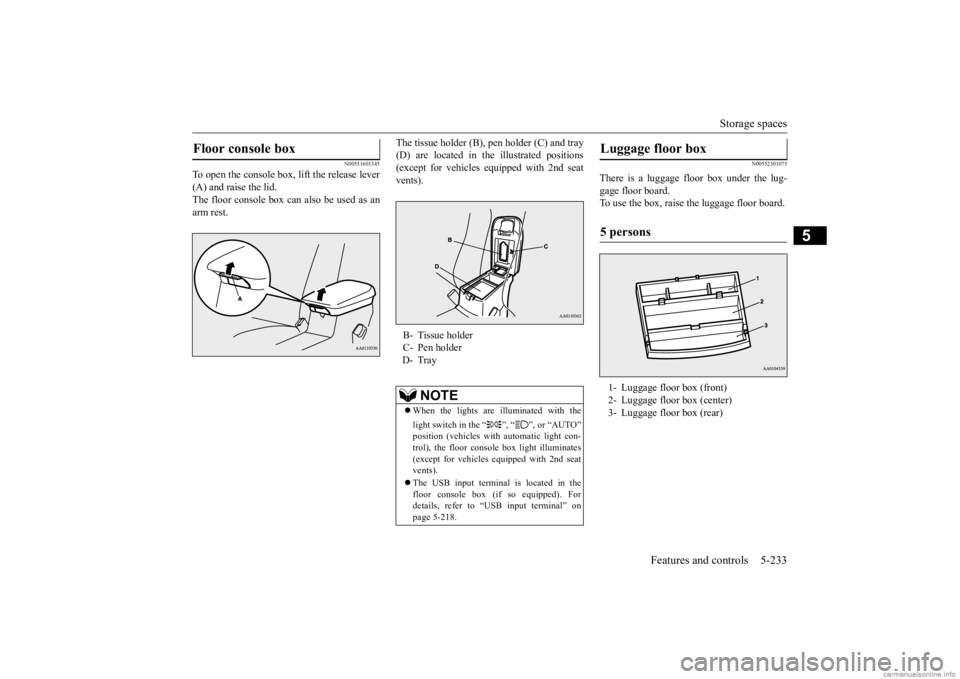
Storage spaces
Features and controls 5-233
5
N00551601345
To open the console box, lift the release lever (A) and raise the lid. The floor console box can also be used as anarm rest.
The tissue holder (B), pen holder (C) and tray (D) are located in the illustrated positions(except for vehicles equipped with 2nd seat vents).
N00552301075
There is a luggage floor box under the lug-gage floor board. To use the box, raise the luggage floor board.
Floor console box
B- Tissue holderC- Pen holder D- Tray
NOTE
When the lights are illuminated with the light switch in the “ ”, “ ”, or “AUTO” position (vehicles with
automatic light con-
trol), the floor consol
e box light illuminates
(except for vehicles
equipped with 2nd seat
vents). The USB input terminal is located in the floor console box (if
so equipped). For
details, refer to “USB input terminal” onpage 5-218.
Luggage floor box 5 persons 1- Luggage floor box (front) 2- Luggage floor box (center)3- Luggage floor box (rear)
BK0278200US.book 233 ページ 2019年4月10日 水曜日 午前10時59分
Page 336 of 443
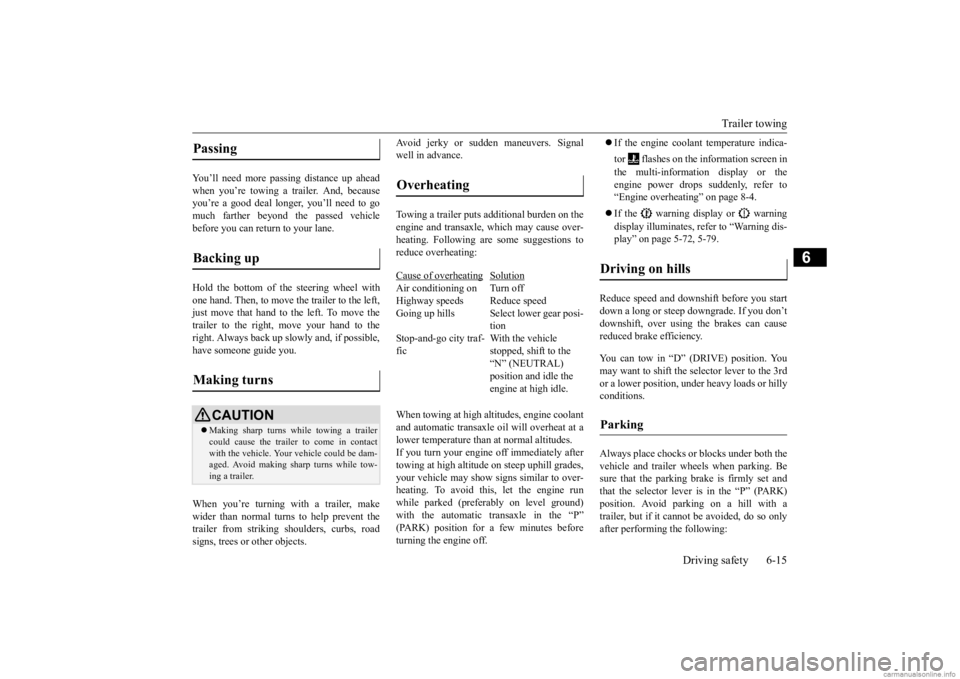
Trailer towing
Driving safety 6-15
6
You’ll need more passing distance up ahead when you’re towing a trailer. And, because you’re a good deal longer, you’ll need to gomuch farther beyond the passed vehicle before you can return to your lane. Hold the bottom of the steering wheel with one hand. Then, to move the trailer to the left,just move that hand to the left. To move the trailer to the right, move your hand to the right. Always back up sl
owly and, if possible,
have someone guide you. When you’re turning with a trailer, make wider than normal turns to help prevent the trailer from striking shoulders, curbs, roadsigns, trees or other objects.
Avoid jerky or sudden maneuvers. Signal well in advance. Towing a trailer puts additional burden on the engine and transaxle,
which may cause over-
heating. Following ar
e some suggestions to
reduce overheating: When towing at high al
titudes, engine coolant
and automatic transaxle oil will overheat at a lower temperature than at normal altitudes. If you turn your engine off immediately aftertowing at high altitude
on steep uphill grades,
your vehicle may show
signs similar to over-
heating. To avoid this
, let the engine run
while parked (preferably on level ground) with the automatic transaxle in the “P” (PARK) position for a few minutes beforeturning the engine off.
If the engine coolant temperature indica- tor flashes on the information screen in the multi-information display or the engine power drops suddenly, refer to “Engine overheati
ng” on page 8-4.
If the warning display or warning display illuminates, re
fer to “Warning dis-
play” on page 5-72, 5-79.
Reduce speed and downshift before you start down a long or steep downgrade. If you don’t downshift, over using the brakes can cause reduced brake efficiency. You can tow in “D” (DRIVE) position. You may want to shift the selector lever to the 3rd or a lower position, under heavy loads or hilly conditions. Always place chocks or blocks under both the vehicle and trailer wheels when parking. Besure that the parking brake is firmly set and that the selector lever is in the “P” (PARK) position. Avoid parki
ng on a hill with a
trailer, but if it cannot be avoided, do so only after performing the following:
Passing Backing up Making turns
CAUTION Making sharp turns while towing a trailer could cause the
trailer to come in contact
with the vehicle. Your
vehicle could be dam-
aged. Avoid making sharp turns while tow- ing a trailer.
Overheating Cause of overheating
Solution
Air conditioning on Turn off Highway speeds Reduce speed Going up hills Select lower gear posi-
tion
Stop-and-go city traf- fic
With the vehicle stopped, shift to the “N” (NEUTRAL) position and idle the engine at high idle.
Driving on hills Parking
BK0278200US.book 15 ページ 2019年4月10日 水曜日 午前10時59分
Page 365 of 443
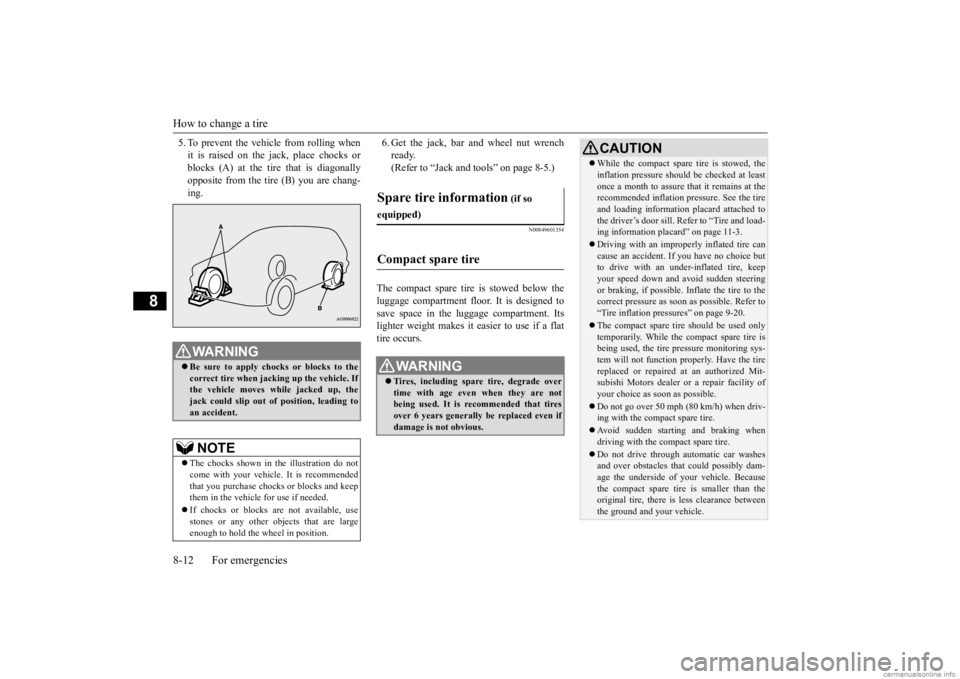
How to change a tire 8-12 For emergencies
8
5. To prevent the vehicle from rolling when it is raised on the jack, place chocks orblocks (A) at the ti
re that is diagonally
opposite from the tire (B) you are chang- ing.
6. Get the jack, bar and wheel nut wrench ready.(Refer to “Jack and t
ools” on page 8-5.)
N00849601354
The compact spare tire is stowed below the luggage compartment floor. It is designed to save space in the luggage compartment. Its lighter weight ma
kes it easier to use if a flat
tire occurs.
WA R N I N G Be sure to apply choc
ks or blocks to the
correct tire when jacking up the vehicle. If the vehicle moves while jacked up, the jack could slip out of
position, leading to
an accident.NOTE
The chocks shown in the illustration do not come with your vehicle. It is recommended that you purchase chocks
or blocks and keep
them in the vehicle for use if needed. If chocks or blocks ar
e not available, use
stones or any other obj
ects that are large
enough to hold the wheel in position.
Spare tire information
(if so
equipped)Compact spare tire
WA R N I N G Tires, including spar
e tire, degrade over
time with age even when they are not being used. It is recommended that tires over 6 years generally
be replaced even if
damage is not obvious.
CAUTION While the compact spare tire is stowed, the inflation pressure shoul
d be checked at least
once a month to assure that it remains at therecommended inflation pressure. See the tire and loading information placard attached to the driver’s door sill. Refer to “Tire and load-ing information placard” on page 11-3. Driving with an imprope
rly inflated tire can
cause an accident. If
you have no choice but
to drive with an under-inflated tire, keep your speed down and av
oid sudden steering
or braking, if possible. Inflate the tire to the correct pressure as soon as possible. Refer to “Tire inflation pressures” on page 9-20. The compact spare tire should be used only temporarily. While th
e compact spare tire is
being used, the tire pr
essure monitoring sys-
tem will not function pr
operly. Have the tire
replaced or repaired at an authorized Mit-subishi Motors dealer or a repair facility of your choice as soon as possible. Do not go over 50 mph (80 km/h) when driv- ing with the compact spare tire. Avoid sudden starting and braking when driving with the
compact spare tire.
Do not drive through automatic car washes and over obstacles that
could possibly dam-
age the underside of your vehicle. Becausethe compact spare tire is smaller than the original tire, there is less clearance between the ground and your vehicle.
BK0278200US.book 12 ページ 2019年4月10日 水曜日 午前10時59分
Page 383 of 443

Air cleaner filter 9-10 Vehicle care and maintenance
9
The radiator cap must be
sealed tight to pre-
vent losing coolant, which may result in engine damage. Only use a Mitsubishi Motors Genuine Parts radiator cap, or anapproved equivalent.
Do not overfill the reserve tank. Your vehicle uses a special radiator cap that stays sealed and lets the coolant flow from the reserve tank back to the radiator when the engine cools down. If you needto change the cap, use the exact same kind. Check the coolant freeze point in the radi- ator with the proper gauge, and only when it is safe. If you add antifreeze, the con- tents of the reserve tank must be protectedagainst freezing. Keep the front of the radiator and con- denser clean. If the engine coolant temperature does not rise after the engine is warmed-up, take your vehicle to an au
thorized Mitsubishi
Motors dealer or a repair facility of your choice to have the thermostat checked, and replaced if necessary.
N00937901494
The air cleaner filter
will get dirty and dusty
from use and not filter
properly. Replace it
with a new filter using the schedule in the“WARRANTY AND MAINTENANCE MANUAL”. 1. For 2.4 L models, remove the two clips (A), then remove the Air duct (B). 2. For 2.4 L models, while holding down the tab (C), pull out the connector (D).
The required concentrati
on of anti-freeze dif-
fers depending on the
expected ambient tem-
perature.Above -31 °F (-35 °C): 50 % concentration of anti-freeze Below -31 °F (-35 °C): 60 % concentrationof anti-freeze You can check the concentration level with a gauge from an automotive supply store, oryour authorized Mitsubi
shi Motors dealer or
service station can check it for you. Do not use water to adjust the concentration of coolant. Do not top off the tank with plain water only. Water by itself boils at a lower temperature and does not stop rust or freezing. If thewater freezes, it will
damage your cooling
system. Do not use tapwater. It can cause corrosion and rust.
Radiator cap
CAUTION
WA R N I N G Wait for the engine to cool down before opening the radiator
cap. Otherwise hot
steam or boiling c
oolant could spray up
from the radiator and scald you.
Points to remember
Air cleaner filter
BK0278200US.book 10 ページ 2019年4月10日 水曜日 午前10時59分
Page 417 of 443

Cleaning the outside of your vehicle 9-44 Vehicle care and maintenance
9
N00945901738
Chemicals cont
ained in the dirt and dust
picked up from air, rain, snow, or road sur- faces can damage the paint and body of yourvehicle if left on. Frequent washing and wa
xing is the best way
to protect your vehicl
e from this damage.
Do not wash the vehicle in direct sunlight. Park the vehicle in the shade and spray it with water to remove dust.
Next, using plenty of
clean water and
a car washing mitt or sponge,
wash the vehicle from top to bottom.Use a mild car washing soap if necessary. Rinse thoroughly and wipe dry with a cham- ois or soft cloth. After washing the vehicle,carefully clean the joints and flanges of the doors, hood, etc., wher
e dirt is likely to
remain.
Salt and other chemical
s used on winter roads
in some geographical ar
eas can have a detri-
mental effect on the vehicle underbody. You should flush the underbody with a high pres- sure hose every time you wash the outside ofyour vehicle. Take special care to
remove mud or other
debris which could trap and hold salt andmoisture. After washing your vehicle, wipe off all waterdrops from the rubber parts around thedoors to prevent the doors from freezing.
Wa s h i n g
CAUTION When washing the underside of your vehicle or the wheels, wear a pair of gloves to pro- tect your hands. If your vehicle is equippe
d with the rain sen-
sor, place the wiper switch lever in the“OFF” position to deacti
vate the rain sensor
before washing the vehi
cle. Otherwise, the
wipers will operate in
the presence of water
spray on the windshield and may get dam- aged as a result.
Never spray or splash
water on the electrical
parts in the engine compartment. This maydamage them. Be careful also when washingthe underbody to ensure that water does not enter the engine compartment. Avoid automatic car washers that use rotat- ing brushes. These brushes may scratch the paint surface and make it dull.Scratches are more not
iceable on darker col-
ored vehicles. Some hot water wash
ing equipment uses
high pressure and heat to clean your vehicle. Because hot water can da
mage plastics parts
and seep inside your ve
hicle, make sure you
do the following when using such equip- ment:• Keep the washing nozzle at least 28 inches(70 cm) away from the vehicle body.• When washing around the door glass, holdthe nozzle at a distance of more than 28inches (70 cm) and at a right angle to the glass surface.
Make sure to do the following when using an automatic car wash, with help from either this manual or the car wash operator, toavoid damaging your vehicle:• Fold the outside rearview mirrors.• Tape or remove the rear wiper arm assem-bly.• If your vehicle is equipped with roof railsor a roof spoiler, check with the car washoperator before using the car wash.CAUTION
• If your vehicle is equipped with the rainsensor, place the wiper switch lever in the“OFF” position to deac
tivate the rain sen-
sor.
During cold weather
NOTE
When the door is frozen, opening it by force may tear off or crack the rubber gasketinstalled around the door. Pour warm water to melt the ice. Be sure to thoroughly wipe off the water after opening the door. To pre-vent freezing of the we
atherstripping on the
doors, hood, etc., treat with silicone lubri- cant.CAUTION
BK0278200US.book 44 ページ 2019年4月10日 水曜日 午前10時59分
Page 434 of 443

Alphabetical index
12-1
12
Numerics
12 V power outlets
............................
5-221
4-wheel drive operation
.......................
5-88
A
Accessory (installation)
.........................
3-6
Active stability control (ASC)
............
5-100
Adaptive Cruise C
ontrol System (ACC)
.......
5-107 Air cleaner filter
.................................
9-10
Air conditioner
Dual-zone automatic climate control air conditioner
.....................................
7-5
Important air condi
tioning operating tips
..
7-13
Air purifier
.........................................
7-14
Airbag
...............................................
4-35
All-wheel drive operation
....................
5-88
Aluminum wheels
...............................
9-46
Anti-lock braking system
.....................
5-97
Arm rest
.............................................
4-10
Assist grip
........................................
5-239
Automatic high beam system
.............
5-203
Automatic transaxle
............................
5-70
Fluid
.....................................
9-12
, 11-7
Selector lever operation
...................
5-70
Selector lever positions
...................
5-73
Sports mode
...................................
5-73
B
Back-up light
Bulb capacity
.................................
9-34
Replacement
..................................
9-40
Ball joint, steering linka
ge seals, drive shaft
boots
...............................................
9-26
Battery
..............................................
9-14
Charging system warning light
.......
5-197
Checking battery
electrolyte level
....
9-14
Disconnection and connection
.........
9-15
During cold weather
.......................
9-15
Specification
..................................
11-6
Blind Spot Warning (BSW)
................
5-127
Bottle holders
....................................
5-236
Brake
Fluid
.....................................
9-14
, 11-7
Brake assist
........................................
5-97
Braking
Anti-lock braking system
................
5-97
Braking
...........................................
6-5
Hose
.............................................
9-25
Pad wear alarm
..............................
5-93
Parking brake
.................................
5-56
Pedal
.............................................
5-92
Pedal free play
...............................
9-23
Power brakes
.................................
5-93
Service brake
.................................
5-92
Warning lights and buzzer
.............
5-196
Break-in recommendations
....................
5-3
Bulb location and capacity
...................
9-34
C
California Perchl
orate Materials
Requirements
.....................................
3-7
Capacities
..........................................
11-7
Card holder
......................................
5-232
Cargo area cover
...............................
5-237
Cargo loads
........................................
6-10
Cargo room light
...............................
5-230
Bulb capacity
.................................
9-35
Catalytic converter
................................
9-2
Cautions on the handling of all-wheel drive vehicles
............................................
5-91
Certification label
...............................
11-3
Charging system warning light
...........
5-197
Child restraint systems
........................
4-27
Child safety locks for rear door
............
5-40
Cleaning
Inside of your vehicle
......................
9-42
Outside of your vehicle
...................
9-43
Coat hook
.........................................
5-239
Consumer information
.........................
10-2
Continuously variable transmission (CVT)
...
5-76
BK0278200US.book 1 ページ 2019年4月10日 水曜日 午前10時59分
Page 435 of 443
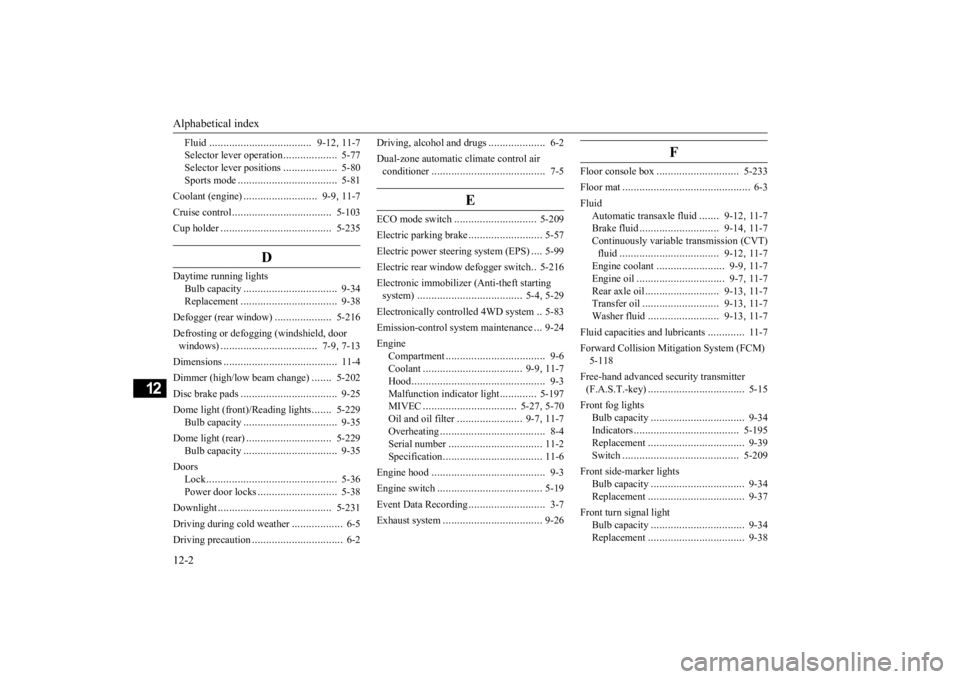
Alphabetical index 12-2
12
Fluid
....................................
9-12
, 11-7
Selector lever operation
...................
5-77
Selector le
ver positions
...................
5-80
Sports mode
...................................
5-81
Coolant (engine)
..........................
9-9
, 11-7
Cruise control
...................................
5-103
Cup holder
.......................................
5-235
D
Daytime running lights
Bulb capacity
.................................
9-34
Replacement
..................................
9-38
Defogger (rear window)
....................
5-216
Defrosting or defogging (windshield, door windows)
..................................
7-9
, 7-13
Dimensions
........................................
11-4
Dimmer (high/lo
w beam change)
.......
5-202
Disc brake pads
..................................
9-25
Dome light (front)/Reading lights
.......
5-229
Bulb capacity
.................................
9-35
Dome light (rear)
..............................
5-229
Bulb capacity
.................................
9-35
Doors
Lock
..............................................
5-36
Power door locks
............................
5-38
Downlight
........................................
5-231
Driving during cold weather
..................
6-5
Driving precaution
................................
6-2
Driving, alcohol and drugs
....................
6-2
Dual-zone automatic climate control air conditioner
........................................
7-5
E
ECO mode switch
.............................
5-209
Electric parking brake
..........................
5-57
Electric power steering system (EPS)
....
5-99
Electric rear window
defogger switch
..5-216
Electronic immobilizer (Anti-theft starting system)
.....................................
5-4
, 5-29
Electronically cont
rolled 4WD system
..5-83
Emission-control system maintenance
...
9-24
Engine
Compartment
...................................
9-6
Coolant
...................................
9-9
, 11-7
Hood
...............................................
9-3
Malfunction indicator light
.............
5-197
MIVEC
.................................
5-27
, 5-70
Oil and oil filter
.......................
9-7
, 11-7
Overheating
.....................................
8-4
Serial number
.................................
11-2
Specification
...................................
11-6
Engine hood
........................................
9-3
Engine switch
.....................................
5-19
Event Data Recording
...........................
3-7
Exhaust system
...................................
9-26
F
Floor console box
.............................
5-233
Floor mat
.............................................
6-3
Fluid
Automatic transaxle fluid
.......
9-12
, 11-7
Brake fluid
............................
9-14
, 11-7
Continuously variable transmission (CVT) fluid
...................................
9-12
, 11-7
Engine coolant
........................
9-9
, 11-7
Engine oil
...............................
9-7
, 11-7
Rear axle oil
..........................
9-13
, 11-7
Transfer oil
...........................
9-13
, 11-7
Washer fluid
.........................
9-13
, 11-7
Fluid capacities and lubricants
.............
11-7
Forward Collision Miti
gation System (FCM)
5-118 Free-hand advanced security transmitter (F.A.S.T.-key)
..................................
5-15
Front fog lights
Bulb capacity
.................................
9-34
Indicators
.....................................
5-195
Replacement
..................................
9-39
Switch
.........................................
5-209
Front side-marker lights
Bulb capacity
.................................
9-34
Replacement
..................................
9-37
Front turn signal light
Bulb capacity
.................................
9-34
Replacement
..................................
9-38
BK0278200US.book 2 ページ 2019年4月10日 水曜日 午前10時59分